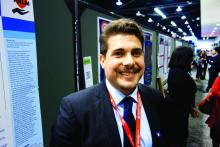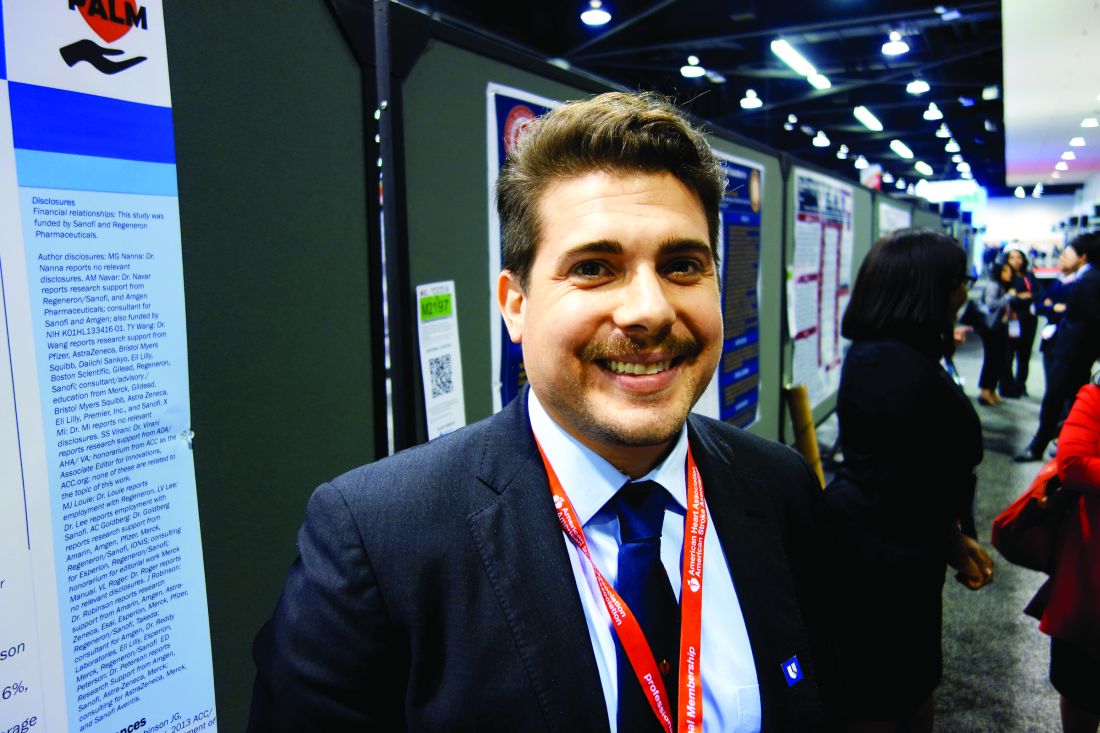User login
ANAHEIM, CALIF. – Adults older than age 75 years with known atherosclerotic cardiovascular disease are significantly less likely than younger patients to receive a high-intensity statin for secondary prevention, even though they actually tolerate statin therapy better, Michael G. Nanna, MD, said at the American Heart Association scientific sessions.
This was among the eye-opening findings from his analysis of data from the PALM (Patient and Provider Assessment of Lipid Management) Registry, a national registry that provides a snapshot of how cardiologists, primary care physicians, and endocrinologists in real-world community practice care for their patients with known atherosclerotic cardiovascular disease (ASCVD) or at high risk for it.
The impetus for this study was the dearth of information about what’s going on in everyday clinical practice in terms of statin utilization and side effects in the elderly since release of the 2013 American College of Cardiology and American Heart Association cholesterol guidelines. Those guidelines highlighted the lack of randomized clinical trial data to support the use of statins in patients over age 75, who had typically been excluded from participation in the major studies.
The guidelines recommended moderate-intensity statin therapy for secondary prevention in the elderly, and didn’t take a firm position regarding statins for primary prevention in older patients.
What’s happening in community practice
For primary prevention in the elderly, physicians appear to be extrapolating from their practice patterns in younger at-risk patients. Sixty-three percent of patients younger than age 75 at high risk for ASCVD were on a statin for primary prevention, as were an equal percentage of older patients. Moreover, 10.2% of older patients were on a high-intensity statin for primary prevention, a rate not significantly different from the 12.3% in younger at-risk patients.
Statin therapy for secondary prevention in the elderly was a different story. Older patients were significantly less likely to receive any statin for secondary prevention. And they were much less likely to get a high-intensity statin, by a margin of 23.5% to 36.2%.
Indeed, in a multivariate regression analysis adjusted for patient demographics, diabetes, smoking, heart failure, body mass index, insurance type, income, and whether a patient saw a cardiologist, older patients with ASCVD were 42% less likely to receive a high-intensity statin than patients younger than age 75.
“It’s interesting that older patients who have ASCVD are actually the group at highest risk of events, yet they’re the least likely to receive a high-intensity statin,” Dr. Nanna observed in an interview.
Of note, older patients were significantly less likely to report any side effect on a statin, by a margin of 41.3% to 46.6%. They were also markedly less likely to report myalgias, by a margin of 23.3% to 33.3%.
“One of the reasons why folks have shied away from treating older patients with statins, and especially with high-intensity statins, is the theoretical risk of more side effects and drug interactions. We didn’t see that,” Dr. Nanna said.
What’s next
“My dream is that studies like this will motivate folks to fund a randomized clinical trial looking at high-intensity statins in older adults,” Dr. Nanna said. “I think there are funding challenges because both rosuvastatin and atorvastatin are generic at this point. But I think it needs to be done.”
Rumor has it, he added, that the first randomized trial of statin therapy in the elderly will be in the primary prevention setting. “That’s an area where we’re all essentially operating in an evidence-free zone,” Dr. Nanna said.
Regeneron and Sanofi fund the PALM Registry. Dr. Nanna reported having no relevant financial conflicts of interest.
ANAHEIM, CALIF. – Adults older than age 75 years with known atherosclerotic cardiovascular disease are significantly less likely than younger patients to receive a high-intensity statin for secondary prevention, even though they actually tolerate statin therapy better, Michael G. Nanna, MD, said at the American Heart Association scientific sessions.
This was among the eye-opening findings from his analysis of data from the PALM (Patient and Provider Assessment of Lipid Management) Registry, a national registry that provides a snapshot of how cardiologists, primary care physicians, and endocrinologists in real-world community practice care for their patients with known atherosclerotic cardiovascular disease (ASCVD) or at high risk for it.
The impetus for this study was the dearth of information about what’s going on in everyday clinical practice in terms of statin utilization and side effects in the elderly since release of the 2013 American College of Cardiology and American Heart Association cholesterol guidelines. Those guidelines highlighted the lack of randomized clinical trial data to support the use of statins in patients over age 75, who had typically been excluded from participation in the major studies.
The guidelines recommended moderate-intensity statin therapy for secondary prevention in the elderly, and didn’t take a firm position regarding statins for primary prevention in older patients.
What’s happening in community practice
For primary prevention in the elderly, physicians appear to be extrapolating from their practice patterns in younger at-risk patients. Sixty-three percent of patients younger than age 75 at high risk for ASCVD were on a statin for primary prevention, as were an equal percentage of older patients. Moreover, 10.2% of older patients were on a high-intensity statin for primary prevention, a rate not significantly different from the 12.3% in younger at-risk patients.
Statin therapy for secondary prevention in the elderly was a different story. Older patients were significantly less likely to receive any statin for secondary prevention. And they were much less likely to get a high-intensity statin, by a margin of 23.5% to 36.2%.
Indeed, in a multivariate regression analysis adjusted for patient demographics, diabetes, smoking, heart failure, body mass index, insurance type, income, and whether a patient saw a cardiologist, older patients with ASCVD were 42% less likely to receive a high-intensity statin than patients younger than age 75.
“It’s interesting that older patients who have ASCVD are actually the group at highest risk of events, yet they’re the least likely to receive a high-intensity statin,” Dr. Nanna observed in an interview.
Of note, older patients were significantly less likely to report any side effect on a statin, by a margin of 41.3% to 46.6%. They were also markedly less likely to report myalgias, by a margin of 23.3% to 33.3%.
“One of the reasons why folks have shied away from treating older patients with statins, and especially with high-intensity statins, is the theoretical risk of more side effects and drug interactions. We didn’t see that,” Dr. Nanna said.
What’s next
“My dream is that studies like this will motivate folks to fund a randomized clinical trial looking at high-intensity statins in older adults,” Dr. Nanna said. “I think there are funding challenges because both rosuvastatin and atorvastatin are generic at this point. But I think it needs to be done.”
Rumor has it, he added, that the first randomized trial of statin therapy in the elderly will be in the primary prevention setting. “That’s an area where we’re all essentially operating in an evidence-free zone,” Dr. Nanna said.
Regeneron and Sanofi fund the PALM Registry. Dr. Nanna reported having no relevant financial conflicts of interest.
ANAHEIM, CALIF. – Adults older than age 75 years with known atherosclerotic cardiovascular disease are significantly less likely than younger patients to receive a high-intensity statin for secondary prevention, even though they actually tolerate statin therapy better, Michael G. Nanna, MD, said at the American Heart Association scientific sessions.
This was among the eye-opening findings from his analysis of data from the PALM (Patient and Provider Assessment of Lipid Management) Registry, a national registry that provides a snapshot of how cardiologists, primary care physicians, and endocrinologists in real-world community practice care for their patients with known atherosclerotic cardiovascular disease (ASCVD) or at high risk for it.
The impetus for this study was the dearth of information about what’s going on in everyday clinical practice in terms of statin utilization and side effects in the elderly since release of the 2013 American College of Cardiology and American Heart Association cholesterol guidelines. Those guidelines highlighted the lack of randomized clinical trial data to support the use of statins in patients over age 75, who had typically been excluded from participation in the major studies.
The guidelines recommended moderate-intensity statin therapy for secondary prevention in the elderly, and didn’t take a firm position regarding statins for primary prevention in older patients.
What’s happening in community practice
For primary prevention in the elderly, physicians appear to be extrapolating from their practice patterns in younger at-risk patients. Sixty-three percent of patients younger than age 75 at high risk for ASCVD were on a statin for primary prevention, as were an equal percentage of older patients. Moreover, 10.2% of older patients were on a high-intensity statin for primary prevention, a rate not significantly different from the 12.3% in younger at-risk patients.
Statin therapy for secondary prevention in the elderly was a different story. Older patients were significantly less likely to receive any statin for secondary prevention. And they were much less likely to get a high-intensity statin, by a margin of 23.5% to 36.2%.
Indeed, in a multivariate regression analysis adjusted for patient demographics, diabetes, smoking, heart failure, body mass index, insurance type, income, and whether a patient saw a cardiologist, older patients with ASCVD were 42% less likely to receive a high-intensity statin than patients younger than age 75.
“It’s interesting that older patients who have ASCVD are actually the group at highest risk of events, yet they’re the least likely to receive a high-intensity statin,” Dr. Nanna observed in an interview.
Of note, older patients were significantly less likely to report any side effect on a statin, by a margin of 41.3% to 46.6%. They were also markedly less likely to report myalgias, by a margin of 23.3% to 33.3%.
“One of the reasons why folks have shied away from treating older patients with statins, and especially with high-intensity statins, is the theoretical risk of more side effects and drug interactions. We didn’t see that,” Dr. Nanna said.
What’s next
“My dream is that studies like this will motivate folks to fund a randomized clinical trial looking at high-intensity statins in older adults,” Dr. Nanna said. “I think there are funding challenges because both rosuvastatin and atorvastatin are generic at this point. But I think it needs to be done.”
Rumor has it, he added, that the first randomized trial of statin therapy in the elderly will be in the primary prevention setting. “That’s an area where we’re all essentially operating in an evidence-free zone,” Dr. Nanna said.
Regeneron and Sanofi fund the PALM Registry. Dr. Nanna reported having no relevant financial conflicts of interest.
REPORTING FROM THE AHA SCIENTIFIC SESSIONS
Key clinical point:
Major finding: Patients over age 75 with known cardiovascular disease were 42% less likely to receive a high-intensity statin for secondary prevention.
Study details: This was an analysis of more than 7,700 patients in the observational PALM Registry conducted in 138 U.S. community cardiology, primary care, and endocrinology practices.
Disclosures: Regeneron and Sanofi fund the PALM Registry. The presenter reported having no financial conflicts of interest.

